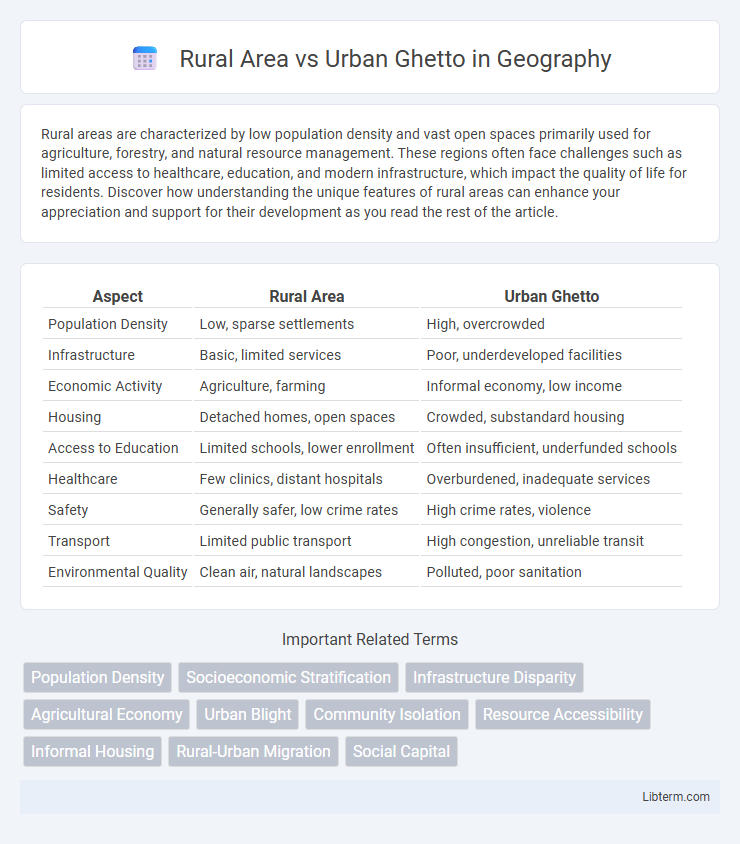Rural areas are characterized by low population density and vast open spaces primarily used for agriculture, forestry, and natural resource management. These regions often face challenges such as limited access to healthcare, education, and modern infrastructure, which impact the quality of life for residents. Discover how understanding the unique features of rural areas can enhance your appreciation and support for their development as you read the rest of the article.
Table of Comparison
| Aspect | Rural Area | Urban Ghetto |
|---|---|---|
| Population Density | Low, sparse settlements | High, overcrowded |
| Infrastructure | Basic, limited services | Poor, underdeveloped facilities |
| Economic Activity | Agriculture, farming | Informal economy, low income |
| Housing | Detached homes, open spaces | Crowded, substandard housing |
| Access to Education | Limited schools, lower enrollment | Often insufficient, underfunded schools |
| Healthcare | Few clinics, distant hospitals | Overburdened, inadequate services |
| Safety | Generally safer, low crime rates | High crime rates, violence |
| Transport | Limited public transport | High congestion, unreliable transit |
| Environmental Quality | Clean air, natural landscapes | Polluted, poor sanitation |
Introduction: Defining Rural Areas and Urban Ghettos
Rural areas are characterized by low population density, expansive open spaces, and economies largely based on agriculture or resource extraction, often facing challenges such as limited access to healthcare and education. Urban ghettos are densely populated neighborhoods within cities, marked by economic hardship, social marginalization, and inadequate infrastructure, frequently resulting from historical segregation and systemic inequality. Understanding these distinct environments highlights the contrasting social, economic, and spatial dynamics that shape residents' lived experiences.
Historical Context and Development
Rural areas historically evolved around agriculture and resource-based economies, with tightly-knit communities shaped by land ownership patterns and limited infrastructure development. Urban ghettos emerged predominantly during industrialization periods, marked by forced segregation and economic marginalization, often rooted in systemic racism and immigration waves. The spatial and social development of these environments reflects contrasting historical pressures: rural regions prioritized land and subsistence, while urban ghettos manifested intense population density, poverty concentration, and infrastructural neglect.
Population Density and Demographics
Rural areas typically feature low population density with dispersed housing and predominately homogeneous demographics, often consisting of older age groups and fewer minority populations. Urban ghettos exhibit extremely high population density with concentrated housing units and diverse demographics marked by significant minority groups and younger populations. These contrasts influence social dynamics, resource allocation, and infrastructure development between the two environments.
Socioeconomic Status and Employment Opportunities
Rural areas often face limited employment opportunities primarily in agriculture and small-scale industries, resulting in lower socioeconomic status compared to urban ghettos that, despite higher unemployment rates, benefit from diverse job markets including manufacturing and service sectors. Urban ghettos experience concentrated poverty, but access to social programs and informal economies can sometimes provide alternative income sources. In contrast, rural communities struggle with outmigration and fewer social services, exacerbating economic disparities and limiting upward mobility.
Education Access and Quality
Rural areas often face limited access to quality education due to fewer schools, inadequate funding, and a shortage of qualified teachers, resulting in lower graduation rates and fewer advanced course offerings. Urban ghettos encounter challenges such as overcrowded classrooms, outdated facilities, and socio-economic barriers that hamper student performance and access to enrichment programs. Both environments suffer from systemic disparities that impede educational equity and long-term socioeconomic mobility.
Healthcare Facilities and Services
Rural areas often face limited healthcare facilities and services, with fewer hospitals and specialized providers compared to urban ghettos, which may have more medical centers but struggle with overcrowding and underfunding. Urban ghettos experience higher rates of chronic diseases and mental health issues due to environmental stressors, while rural populations face challenges related to transportation and shortage of healthcare professionals. Access to quality care in both settings is hindered by economic disparities and systemic barriers, impacting overall health outcomes significantly.
Housing Conditions and Infrastructure
Rural areas typically feature more spacious housing with access to natural environments but often suffer from inadequate infrastructure such as limited road quality, unreliable water supply, and insufficient healthcare facilities. Urban ghettos exhibit dense, overcrowded housing conditions with poorly maintained buildings and restricted access to essential services like sanitation, electricity, and transportation. Infrastructure disparities in urban ghettos compound social challenges, while rural housing conditions reflect geographic isolation and limited economic investment.
Social Challenges and Crime Rates
Rural areas often face social challenges such as limited access to healthcare, education, and economic opportunities, which can contribute to higher rates of poverty and social isolation. Urban ghettos typically experience higher crime rates, including violent crimes and drug-related offenses, driven by dense population, unemployment, and systemic inequality. Both settings require targeted policies addressing economic development, social services, and law enforcement to mitigate their distinct social and crime-related issues.
Cultural Identity and Community Life
Rural areas often maintain strong cultural identities rooted in long-standing traditions, agricultural practices, and close-knit family ties, fostering a sense of belonging and communal support. Urban ghettos, shaped by socioeconomic challenges and diverse immigrant populations, develop unique cultural expressions through music, art, and street life, reflecting resilience and adaptation. Community life in rural settings revolves around shared heritage and cooperation, while urban ghettos emphasize grassroots organizations and collective efforts to address social inequalities.
Future Prospects and Policy Recommendations
Future prospects for rural areas include leveraging agricultural innovation and sustainable development to boost local economies, while urban ghettos require targeted interventions addressing economic disparities and infrastructure deficits. Policy recommendations emphasize investing in education, affordable housing, and healthcare access in urban ghettos, alongside enhancing connectivity, technological adoption, and diversified income sources in rural regions. Integrating community-driven planning with governmental support ensures balanced growth and reduces socio-economic inequalities.
Rural Area Infographic

 libterm.com
libterm.com